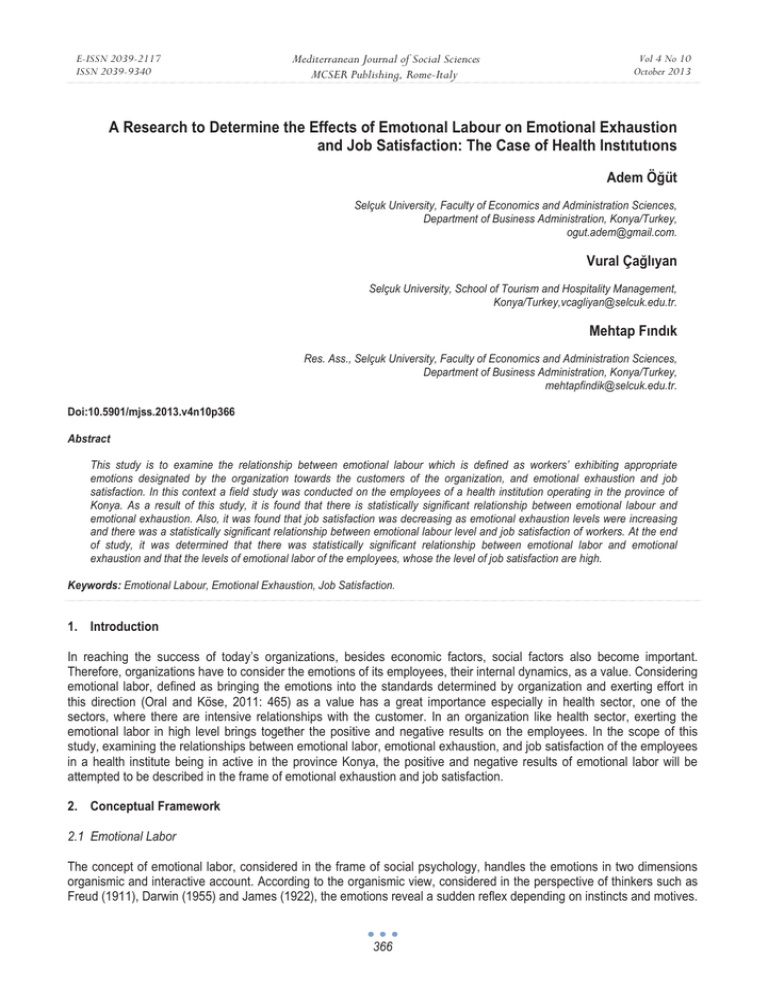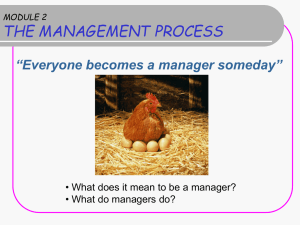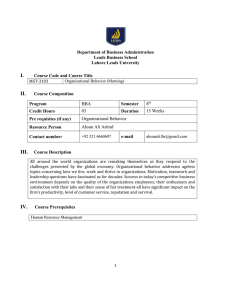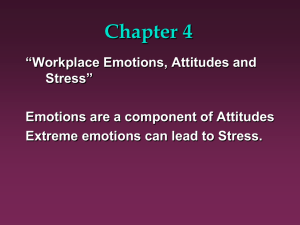A Research to Determine the Effects of EmotÖonal Labour on... and Job Satisfaction: The Case of Health InstÖtutÖons
advertisement

E-ISSN 2039-2117 ISSN 2039-9340 Mediterranean Journal of Social Sciences MCSER Publishing, Rome-Italy Vol 4 No 10 October 2013 A Research to Determine the Effects of EmotÖonal Labour on Emotional Exhaustion and Job Satisfaction: The Case of Health InstÖtutÖons Adem Öøüt Selçuk University, Faculty of Economics and Administration Sciences, Department of Business Administration, Konya/Turkey, ogut.adem@gmail.com. Vural ÇaølÖyan Selçuk University, School of Tourism and Hospitality Management, Konya/Turkey,vcagliyan@selcuk.edu.tr. Mehtap FÖndÖk Res. Ass., Selçuk University, Faculty of Economics and Administration Sciences, Department of Business Administration, Konya/Turkey, mehtapfindik@selcuk.edu.tr. Doi:10.5901/mjss.2013.v4n10p366 Abstract This study is to examine the relationship between emotional labour which is defined as workers’ exhibiting appropriate emotions designated by the organization towards the customers of the organization, and emotional exhaustion and job satisfaction. In this context a field study was conducted on the employees of a health institution operating in the province of Konya. As a result of this study, it is found that there is statistically significant relationship between emotional labour and emotional exhaustion. Also, it was found that job satisfaction was decreasing as emotional exhaustion levels were increasing and there was a statistically significant relationship between emotional labour level and job satisfaction of workers. At the end of study, it was determined that there was statistically significant relationship between emotional labor and emotional exhaustion and that the levels of emotional labor of the employees, whose the level of job satisfaction are high. Keywords: Emotional Labour, Emotional Exhaustion, Job Satisfaction. 1. Introduction In reaching the success of today’s organizations, besides economic factors, social factors also become important. Therefore, organizations have to consider the emotions of its employees, their internal dynamics, as a value. Considering emotional labor, defined as bringing the emotions into the standards determined by organization and exerting effort in this direction (Oral and Köse, 2011: 465) as a value has a great importance especially in health sector, one of the sectors, where there are intensive relationships with the customer. In an organization like health sector, exerting the emotional labor in high level brings together the positive and negative results on the employees. In the scope of this study, examining the relationships between emotional labor, emotional exhaustion, and job satisfaction of the employees in a health institute being in active in the province Konya, the positive and negative results of emotional labor will be attempted to be described in the frame of emotional exhaustion and job satisfaction. 2. Conceptual Framework 2.1 Emotional Labor The concept of emotional labor, considered in the frame of social psychology, handles the emotions in two dimensions organismic and interactive account. According to the organismic view, considered in the perspective of thinkers such as Freud (1911), Darwin (1955) and James (1922), the emotions reveal a sudden reflex depending on instincts and motives. 366 E-ISSN 2039-2117 ISSN 2039-9340 Mediterranean Journal of Social Sciences MCSER Publishing, Rome-Italy Vol 4 No 10 October 2013 Interactive account, described in the basis of Freudian and Neo-Freudian thought and considered by social psychologists such as Gert and Mill (1964), Goffman (1956), Lazarus (1966), puts forward that in showing and reflecting the emotions, the role of social factors should be included in the model (Hochschild, 1979: 553-555). In 1983, in the book, called “The Managed Heart”, of Hochschild, this approach was first time defined as emotional labor and has begun to develop. Hochschild (1983: 7) defined the emotional labor as making a facial and physical indication, arranging the emotions, as a necessity of job, so that the others can see them. When the literature of emotional labor is examined, it is seen that emotional labor is considered in three dimensions as deep acting, surface acting, and genuine emotions. Deep acting is a process to control of the employee his/her emotions and thoughts as a necessity of indication rules (Brotheridge and Grandey, 2002: 22). Surface acting is that employees, in the frame of the institutional and professional indication rules, fixing their emotions, reflect them on the customer or receiver in different way from the emotions they actually feel (Hochschild, 1983; Brotheridge and Grandey, 2002: 22; BasÕm and Begenirbaú, 2012: 79). And genuine emotions are expressed that the employee reflects out his/her emotions inherently (BasÕm and Begenirbaú, 2012: 79). 2.2 Emotional Exhaustion Emotional exhaustion, a dimension of burnout, is defined as exhaustion of the emotions and feelings of individual toward the other people (Leiter and Maslach, 1988: 297; Bruce, 2009: 58, YÕldÕrÕm and øçerli, 2010: 124). Emotional exhaustion represents the dimension of basic stress of burnout (Maslach and Goldberg, 1998: 64). When the relationship between burnout and emotional labor is examined, burnout is evaluated as an outcome of emotional labor. Grandey (2000), in his study he conducted, in case that in the relationships with the customer, the emotional participation is high, put forward that burnout emerged. Brotheridge and Grandey (2002), in their studies they conducted, determined a positive relationship between the dimensions of emotional exhaustion and depersonalization of burnout and the dimensions of deep and surface acting of emotional labor. Kim (2008), in the study he conducted, determined a positive relationship between surface acting, considered the sub-dimension of emotional labor, and emotional exhaustion and depersonalization, considered the sub-dimension of burnout. Similarly, Lee and Ok (2012), in their studies, considered the emotional labor as an emotional effort and put forward that there was a positive relationship between emotional effort and emotional exhaustion. 2.3 Job Satisfaction Job satisfaction is defined in the organizational literature in many ways, but the most general definition on job satisfaction is in the form that it is a satisfying or positive emotional state from evaluating of individual his/her job or work experience (Locke, 1976:1300). Job satisfaction is the degree of at which degree the needs and expectations of employee are met. Spector also defined the job satisfaction as at what degree the employees like their jobs (Lee and Ok, 2012: 1103) Job satisfaction is one of the concepts, which emotional labor is most associated with In the studies carried out, while the view that emotional labor negatively affects job satisfaction prevails, there are also some studies suggesting that there are also positive relationships between job satisfaction and emotional labor (Oral and Köse, 2011: 474). Pugliesi (1999), in his study, considered job satisfaction as a behavioral outcome of emotional labor and argued that there was a positive directional relationship between job satisfaction and emotional labor. Yang and Chang (2008), in the study they carried out on clinical nurses, they argued that there was a positive relationship between the dimensions of surface acting and deep acting of emotional labor and job satisfaction. 3. Research Methodology In this section of the study, information will be given about the aim, hypotheses, and findings of study realized by using the method of survey. In addition, whether or not the results obtained in the study were statistically significant will be assessed and whether or not the hypotheses are confirmed will be tested. 3.1 Method of Study and Sample In forming the dataset of this study, method of survey was utilized from the method of survey, the study was carried out on the employees of a health institute (since the institute did not permit about publishing its name, in the study, the 367 Mediterranean Journal of Social Sciences MCSER Publishing, Rome-Italy E-ISSN 2039-2117 ISSN 2039-9340 Vol 4 No 10 October 2013 expression of health institute took place) being in active in the province Konya. In the studies, the data were collected by means of standard questionnaire prepared by regarding to likert scale and via face to face interviews conducted with the responders. The items in the scale were put in order in the form “1 = I definitely disagree” and “5 = I definitely agree”. In the study, in determining the points to be included in the sample, convenience sampling method, used in the similar studies (Cui et. al., 2003; Zhou, 2004), was chosen. Convenience sampling, since it provided the possibility to rapidly access to a number of dates, was a preferred method (Nakip, 2003). In calculating the sample size, YazÕcÕo÷lu and Erdo÷an (2004: 50) were utilized. The authors, for confidentiality value α= 0.05 with equation error +- 0.05, and in the condition that the rate of being observed and not being observed of each x variable in the universe is accepted equal, in case of having a sample size of 500 people, calculated the number of survey that should be conducted as 217. In this context, the rate of survey that should be returned is approximately 44%. In the health institution, where the study was carried out, 280 health personnel work and as a result of application made, 128 questionnaires, suitable to asses, were obtained. The return rate, obtained in this context, is approximately 45% and it can be said that this represents the main body. 3.2 The Aim and Hypotheses of the Study The aim of study is to determine the levels of emotional labor, emotional exhaustion and job performance of the employees of a health institute being in active in health sector in the province Konya and to examine the relationships between the levels of emotional labor, emotional exhaustion, and job performance. In the direction of this aim, the hypotheses developed in the scope of study were put in order as follows. Hypothesis 1: “There is a statistically significant relationship between the level of emotional labor and emotional exhaustion of health staff”. Hypothesis 2: “There is a statistically significant relationship between the level of emotional labor and job performance of health staff”. 3.3 The Scales Used in the Study In the study, in order to determine the levels of emotional labor of the employees of health institute, “Scale of Emotional Labor”, including some items of emotional labor scales by Grandey (2000) and Kruml and Geddes (2000), developed by Diefendorff et al. (2005), and adapted to Turkish by BasÕm and Begenirbaú (2012) was used; in order to measure the level of burnout, “Scale of Burnout”, developed by Maslach and Jackson (1981) and adapted to Turkish by Ergin (1992); and in order to determine the levels of job satisfaction, “Scale of Job Satisfaction”, developed by Spector (1994) used in their studies. 4. Findings Of Studies 4.1 Specifications of Sample Table1. Demographic Characteristics of the Sample Gender of Those Participating in The Study Female Male Total Titles of Those Participating in the Study Research Assistant Doctor Specialist Doctor Asst. Prof. Dr. Assoc. Prof. Dr. Prof. Dr. Total The unit, where those participating in the study work Basic Medicine Surgical Medicine 368 Number 31 60 91 Percent 34,1 65,9 100,0 53 12 26 22 13 126 42,1 9,5 20,6 17,5 10,3 100,0 9 53 7,5 44,2 Mediterranean Journal of Social Sciences MCSER Publishing, Rome-Italy E-ISSN 2039-2117 ISSN 2039-9340 Internal Medicine Total Vol 4 No 10 October 2013 58 120 48,3 100,0 Note: (i) n=113. 4.2 Findings about Emotional Labor In order to determine the levels of emotional labor of those participating in the study, the items taking place in Table 1 were asked in the form of 5-point likert scale. In the scale, 1 is in the meaning of “disagreeing at all” and 5 is in the meaning of agreeing in very high level. The results are seen as follows: Table2. Level of Emotional Labor Scale of Emotional Labor While I am engaged in the patients, I pretend to feel self well. In order to be able to exhibit the emotions my profession requires, I pretend to take on a masque. While I am engaged in the patients, as if I am making a show, I exhibit an extra performance. I play act for being able to be interested in the patients appropriately While I am performing my profession, I behave as if I feel the emotions I do not feel I exhibit the different emotions other than those I actually feel to the patients. Surface Acting I exert effort to also actually feel the emotions I have to show I try to actually experience the emotions I have to show to the patients I show an intensive effort in order to be able to feel inside of me In order to be able to feel the emotions I have to show to the patients, I do everything as much as possible Deep Acting The emotions I showed to the patents spontaneously reveal. The emotions I exhibit to the patients are friendly The emotions I showed to the patients is the same as those I felt at that moment. While I am engaged in the patients, I show false emotions. Genuine Emotions General Total∗ Notes: (i) n=113, (ii) in the scale, I is in the meaning of “I definitely disagree” and 5, in the meaning of “I According to two way Anova Test of Friedman, Ȥ2=636,045; p<0,001; the results are statistically significant. Mean 2,22 2,23 2,04 1,97 2,23 2,27 12,77 2,90 3,04 2,61 2,96 11,27 3,63 3,89 3,58 1,98 12,95 37,55 definitely SD 1,29 1,22 1,22 1,15 1,21 1,20 6,13 1,41 1,32 1,32 1,34 4,21 1,08 1,00 1,13 1,14 2,41 7,92 agree” (iii). When Table 2 is examined, it can be said that the answers of participants associated with each dimension predominantly range in the low level. In other words, the levels of emotional labor are low. While the scores on the dimensions of surface acting and deep acting are at low level in the context of scale, genuine emotions is higher compared to the other two dimensions in the context of scale. This case can be evaluated that employees reflect their genuine emotions to their patients in the working environment. 4.3 Findings About Emotional Exhaustion In order to determine the levels of emotional exhaustion, items taking place in Table 3 were asked in the form of 5-point likert scale. In the scale, 1 is in the meaning of “disagreeing at all” and 5 is in the meaning of agreeing in very high level. The results are seen as follows: Table3. Scale of Emotional Exhaustion Scale of Emotional Exhaustion I feel that I am alienated to my job. I feel myself emotionally exhausted after return from the job. ∗ Mean. 2,47 2,82 SD 1,31 1,33 Cronbach's alpha values of the variables examined after added points related to variables. Cronbach's alpha value of the scale is 0,719. The Cronbach's alpha values show that the scale was highly reliability and possible to use total score by related to item scores of variables. 369 E-ISSN 2039-2117 ISSN 2039-9340 Mediterranean Journal of Social Sciences MCSER Publishing, Rome-Italy Vol 4 No 10 October 2013 When I wake up in the morning, I cannot bear to this more 2,39 1,21 Striving with the people having problem is really back-breaking . 3,14 1,31 I feel being sick of the work I do. 2,70 1,34 I think that my job constrained me. 2,81 1,43 I think that I work too much on my job. 3,07 1,35 Directly working with people is creating stress on me. 2,79 1,04 I feel that I reach at the end of the way. 2,28 1,32 24,59 7,78 Emotional Exhaution ∗ Notes: (i) n=107, (ii) in the scale, I is in the meaning of “I definitely disagree” and 5, in the meaning of “I definitely agree” (iii). According to two way Anova Test of Friedman, Ȥ2=638,976; p<0,001; the results are statistically significant. When Table 3 is examined, it can be said that the answers of participants associated with each dimension predominantly range in the low level. When the results in the table are generally assessed, it can be said that the exhaustion occurring in the feelings emotions of the employees working in the health institute is in low level. 4.4 Findings About Job Satisfaction In order to determine the levels of job satisfaction, items taking place in Table 4 were asked in the form of 5-point likert scale. In the scale, 1 is in the meaning of “disagreeing at all” and 5 is in the meaning of agreeing in very high level. The results are seen as follows: Table4. Level of Job Satisfaction of Employees Scale of Job Satisfaction I feel I am being paid a fair amount for the work I do. There is really too little chance for promotion on my job. My supervisor is quite competent in doing his/her job. I am not satisfied with the benefits I receive. When I do a good job, I receive the recognition for it that I should receive. Many of our rules and procedures make doing a good job difficult. I like the people I work with. I sometimes feel my job is meaningless. Communications seem good within this organization. Raises are too few and far between. Those who do well on the job stand a fair chance of being promoted. My supervisor is unfair to me. The benefits we receive are as good as most other organizations offer. I do not feel that the work I do is appreciated. My efforts to do a good job are seldom blocked by red tape. I find I have to work harder at my job because of the incompetence of people I work with. I like doing the things I do at work. The goals of this organization are not clear to me. I feel unappreciated by the organization when I think about what they pay me. People get ahead as fast here as they do in other places. My supervisor shows too little interest in the feelings of subordinates. The benefit package we have is equitable. There are few rewards for those who work here. I have too much to do at work. I enjoy my coworkers. I often feel that I do not know what is going on with the organization. I feel a sense of pride in doing my job. I feel satisfied with my chances for salary increases. ∗ Mean 2,73 2,49 3,73 3,24 3,43 2,94 3,93 2,66 3,69 3,65 3,11 2,56 2,88 2,69 2,86 2,96 3,66 2,79 3,07 2,89 2,55 2,81 3,08 3,38 3,66 2,85 3,87 3,01 SD. 1,32 1,27 1,04 1,21 1,05 1,23 1,08 1,35 0,98 1,10 1,27 1,39 1,13 1,38 1,26 1,27 1,14 1,33 1,28 1,23 1,33 1,17 1,19 1,07 1,15 1,24 1,18 1,33 Cronbach's alpha values of the variables examined after added points related to variables. Cronbach's alpha value of the scale is 0,800. The Cronbach's alpha values show that the scale was highly reliability and possible to use total score by related to item scores of variables. 370 Mediterranean Journal of Social Sciences MCSER Publishing, Rome-Italy E-ISSN 2039-2117 ISSN 2039-9340 There are benefits we do not have which we should have. 3,02 I like my supervisor. 3,52 I have too much paperwork. 3,18 I don't feel my efforts are rewarded the way they should be. 3,04 I am satisfied with my chances for promotion. 3,40 There is too much bickering and fighting at work. 2,73 My job is enjoyable. 3,67 Work assignments are not fully explained. 2,87 112,57 Total∗ Notes: (i) n=108, (ii) in the scale, I is in the meaning of “I definitely disagree” and 5, in the meaning of “I According to two way Anova Test of Friedman, Ȥ2=732,516; p<0,001; the results are statistically significant. Vol 4 No 10 October 2013 1,36 1,21 1,21 1,21 1,19 1,27 1,15 1,25 14,96 definitely agree” (iii) When the table 4 is examined, it can be said that the evaluations of individuals working in the health institutes on the level of job satisfaction are in the medium level, in other words, that the levels of work satisfaction of the employees are in middle or higher level. 4.5 Hypotheses of Study The evaluation about hypotheses developed in the context of study will be done in this section. The first hypothesis of this study is to scrutinize whether or not there is a relationship between the level of emotional labor and emotional exhaustion of health staff. In order to evaluate this situation, the correlation level between scales and the level of relationship was calculated by using Pearson correlation coefficient (Table 5). Table5. Correlation Matrix for Level of Emotional Labor and Burnout Emotion Surface Acting Deep Acting Genuine Emotions Emotional Labor Emotional Exhaustion Note: **p<.001, *p<.05 Surface Acting Deep Acting Genuine Emotions Emotional Labor Emotional Exhaustion 1 ,234(**) 1 -,379(**) -0,051 1 ,794(**) ,708(**) -0,016 1 ,435(**) ,196(*) -,211(*) ,382(**) 1 As seen in correlation matrix in Table 5, there is a statistically significant relationship (p < .001) between the level of emotional labor and burnout emotion. In this case, Hypothesis 1 putting forward that there is a statistically significant relationship between the level of emotional labor and emotional exhaustion of health staff was accepted. In the scope of the second hypothesis of the study will be evaluated toward determining the relationship between job satisfaction and emotional labor of health staff. In order to evaluate this situation in similar to the method applied by Dean and Snell (1996), the employees participating in the study, according to the median rule, are divided into two groups. The effect of level of emotional labor of the employees on job satisfaction is seen in Table 6. Table 6. The Effect of Level of Emotional Labor of the Employees on Job Satisfaction Job Satisfaction Mann Whitney U Tests Low High Emotional Labor (n=65) (n=63) Mean Std. Dev. Mean Std. Dev. Z p Surface Acting 11,58 5,61 14,00 6,43 -2,167 p <,05 Deep Acting 10,55 4,27 12,00 4,05 -1,861 p <,05 Genuine Emotions 12,80 2,14 13,11 2,67 -0,703 p >,05 Emotional Labor 34,94 6,66 39,11 8,37 -2,478 p <,05 ∗ Cronbach's alpha values of the variables examined after added points related to variables. Cronbach's alpha value of the scale is 0.782. The Cronbach's alpha values show that the scale was highly reliability and possible to use total score by related to item scores of variables. 371 E-ISSN 2039-2117 ISSN 2039-9340 Mediterranean Journal of Social Sciences MCSER Publishing, Rome-Italy Vol 4 No 10 October 2013 Notes: (i) n=128, (ii) in the scale, I is in the meaning of “I definitely disagree” and 5, in the meaning of “I definitely agree”. When Table 6 is evaluated, it was determined that the levels of emotional labor of the employees, whose the levels of job satisfaction is high, is also high and that these results are statistically significant in the dimension of surface acting and deep acting of emotional labor and generally in the level of emotional labor. øt is seen that Hypothesis 2, developed in the way that “There is statistically significant relationship between the level of emotional labor and job satisfaction of health staff”, is partly supported. 5. Conclusion In this study, the relationships between the levels of emotional labor and emotional exhaustion of the employees of health institute and their job satisfaction were scrutinized. According to the results of study, it was determined that the levels of emotional labor and job satisfactions of the employees in health institute were in medium level and that their level of emotional exhaustion was in low level. Emotional labor was determined in three sub-dimensions as surface acting, deep acting, and genuine emotions and a statistically significant relationship was determined between these subdimensions and emotional exhaustion. It was concluded that there was a negative directional relationship between emotional exhaustion and genuine emotions and that there was a positive directional and statistically significant between the behaviors of surface acting and deep acting. When the relationship between emotional labor and job satisfaction is examined, it was seen that job satisfaction had positive effects on the level of motional labor. In the sample of the study, it was reached the conclusion that the level of emotional labor of the employees, whose the level of job satisfaction are high, were also high. This situation is in quality supporting the studies carried out in the literature (Yang and Chang, 2008; Kim, 2008; Brotheridge and Grandey, 2002; Lee and Ok, 2012). In this context, that the further studies, due to some limitation in health sector, are carried out in the different sector in different sample size can be suggested in terms of generalizability of study. Let’s make this explanation different slightly. References Basim, N., Begenirbaú, M. (2012). ÇalÕúma YaúamÕnda Duygusal Emek: Bir Ölçek Uyarlama ÇalÕúmasÕ, Yönetim ve Ekonomi Dergisi, Cilt:19 SayÕ:1, 77-90. Brotheridge, C.M., Grandey, A.A. (2002). Emotional Labor and Burnout: Comparing Two Perspectives of “People Work”, Journal of Vocational Behavior, 60, 17–39. Bruce, S.P. (2009). Recognizing Stress and Avoiding Burnout, Currents in Pharmacy Teaching and Learning, Vol. 1, 57–64. Cui, C.C., Lewis, B.R., Park, W. (2003).Service Quality Measurement in The Banking Sector in South Korea, International Journal of Bank Marketing, 21(4), 191-201. Diefendorff, J.M., Croyle, M.H., R.H. Grosserand (2005). The Dimensionality and Antecedents of Emotinal Labor Strategies, Journal of Vocational Behavior, Vol. 66, 339-357. Ergin, C. (1992). Doktor ve Hemúirelerde Tükenmiúlik ve Maslach Tükenmiúlik Ölçe÷inin UyarlanmasÕ, R.Bayraktar, ø. DAö (Ed.), VII. Ulusal Psikoloji Kongresi Bilimsel ÇalÕúmalarÕ, Ankara, 143-154. Grandey, A.A. (2000). Emotional Regulation in the Workplace: A New Way to Conceptualize Emotional Labor, Journal of Occupational Health Psychology, 5 (1), 95-110. Hochschild, A. R. (1979). Emotion Work, Feeling Rules, and Social Structure, American Journal of Sociology, 85 (3), 551-75. Hochschild, A.R. (1983). The Managed Hearth: Commercialization of Human Feeling, Berkeley: University of California Press. KIM, H.J. (2008). Hotel Service Providers’ Emotional Labor: The Antecedents and Effects on Burnout, International Journal of Hospitality Management, Vol. 27,151–161. Kruml, S.M. ve D. Geddes (2000). Exploring The Dimensins of Emotional Labor:The Heart of Hoschshild’s Work, Management Comunication Quarterly, Vol.14, 8-49. Lee, JH. J., Ok C. (2012). Reducing Burnout and Enhancing Job Satisfaction: Critical Role of Hotel Employees’ Emotional Intelligence and Emotional Labor, International Journal of Hospitality Management, Vol. 31, 1101– 1112. Leiter, M.P., Maslach, C. (1988). The Impact of Interpersonal Environment on Burnout and Organizational Commitment, Journal of Organizational Behavior, Vol. 9, 297-308. Locke, E.A. (1976). The Nature and Causes of Job Satisfaction, in Dunnette, M.D. (Ed.), Handbook of Industrial and Organizational Psychology, Rand McNally, Chicago, IL, 1297-349. Maslach, C., Goldberg, J. (1998). Prevention of Burnout: New Perspectives, Applied & Preventive Psychology, Vol. 7, 63-74. Maslach, C., Jackson, S.E. (1981). The Measurement of Experienced Burnout, Journal Of Occupational Behaviour, Vol. 2, 99-113. Nakip, M. (2003). Pazarlama AraútÕrmalarÕ Teknikler ve (SPSS Destekli) Uygulamalar, Seçkin YayÕncÕlÕk, Ankara. 372 E-ISSN 2039-2117 ISSN 2039-9340 Mediterranean Journal of Social Sciences MCSER Publishing, Rome-Italy Vol 4 No 10 October 2013 Oral, L., Köse, S. (2011). Hekimlerin Duygusal Emek KullanÕmÕ øle øú Doyumu Ve Tükenmiúlik Düzeyleri ArasÕndaki øliúkiler Üzerine Bir AraútÕrma, Suleyman Demirel University The Journal of Faculty of Economics and Administrative Sciences,Vol.16, No.2, 463492. Pugliesi, K. (1999). The Consequences of Emotional Labor: Effects on Work Stress, Job Satisfaction, and Weil-Being, Motivation and Emotion, Vol. 23, No. 2, 125-154. Spector, P. R. (1994). Job Satisfaciton Scale, http://shell.cas.usf.edu/~pspector/scales/JssEnglish.doc. Yang, F.H., Chang C.C. (2008). Emotional Labour, Job Satisfaction and Organizational Commitment Amongst Clinical Nurses: A Questionnaire Survey, International Journal of Nursing Studies, Vol. 45, 879–887. Yazicio÷lu, Y., Erdo÷an, S. (2004). SPSS UygulamalÕ Bilimsel AraútÕrma Yöntemleri, Detay YayÕncÕlÕk, Ankara. Yildirim, M. H., øçerli, L. (2010). Tükenmiúlik Sendromu: Maslach Ve Kopenhag Tükenmiúlik Ölçeklerinin KarúÕlaútÕrmalÕ Analizi, Organizasyon ve Yönetim Bilimleri Dergisi, Vol. 2, No. 1, ISSN: 1309 -8039, 123-131. Zhou, L. (2004). A Dimension-Specific Analysis of Performance only Measurement of Service Quality and Satisfaction in China’s Retail Banking, Journal of Services Marketing, 18(7), 534-546. 373





